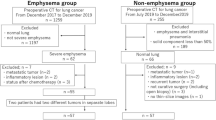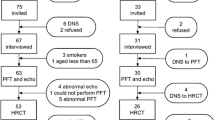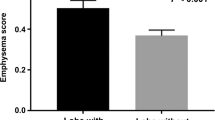Abstract
Purpose
The present study evaluated the sex-specific susceptibility to the development of emphysema in patients with smoking histories who underwent lung cancer surgeries.
Methods
Lung cancer patients with smoking histories who underwent lung resection at the University of Tsukuba Hospital, Japan, were enrolled. Radiologic emphysematous changes were analyzed using three-dimensional computed tomography (3D-CT). The volume proportion of emphysematous lung per unit of smoking and the relationship between emphysematous change and clinicopathologic factors were evaluated.
Results
Radiologic emphysematous changes analyzed using 3D-CT per pack-year smoked, defined as the Smoking-Emphysema Index (SEI), were greater in females than males. The difference was more profound in adenocarcinoma patients than in non-adenocarcinoma patients (0.70 ± 2.30 vs. 0.21 ± 0.28, P = 0.037).
Conclusion
Female lung cancer patients are more susceptible to smoking-induced emphysema than males. The SEI may be an effective indicator for evaluating smoking-induced emphysema.




Similar content being viewed by others
Abbreviations
- 3D-CT:
-
Three-dimensional computed tomography
- COPD:
-
Chronic obstructive pulmonary disease
- FEV1.0%:
-
Forced expiratory volume in 1 s
- HU:
-
Hounsfield units
- LAV%:
-
Low-attenuation volume percentage
- SEI:
-
Smoking-emphysema index
- Smokers:
-
Current and past smokers
- VC%:
-
Vital capacity predicted
References
Lee PN, Forey BA, Coombs KJ. Systematic review with meta-analysis of the epidemiological evidence in the 1900s relating smoking to lung cancer. BMC Cancer. 2012;12:385.
Forey BA, Thornton AJ, Lee PN. Systematic review with meta-analysis of the epidemiological evidence relating smoking to COPD, chronic bronchitis and emphysema. BMC Pulm Med. 2011;11:36.
López-Campos JL, Tan W, Soriano JB. Global burden of COPD. Respirology. 2016;21(1):14–23.
Torre LA, Siegel RL, Jemal A. Lung cancer statistics. Adv Exp Med Biol. 2016;893:1–19.
Bray F, Ferlay J, Soerjomataram I, Siegel RL, Torre LA, Jemal A. Global cancer statistics 2018: GLOBOCAN estimates of incidence and mortality worldwide for 36 cancers in 185 countries. CA Cancer J Clin. 2018;68(6):394–424.
Zulueta JJ, Wisnivesky JP, Henschke CI, Yip R, Farooqi AO, McCauley DI, et al. Emphysema scores predict death from COPD and lung cancer. Chest. 2012;141(5):1216–23.
Durham AL, Adcock IM. The relationship between COPD and lung cancer. Lung Cancer. 2015;90(2):121–7.
Wang Q, Takashima S, Wang JC, Zheng LM, Sone S. Prevalence of emphysema in individuals who underwent screening CT for lung cancer in Nagano prefecture of Japan. Respiration. 2001;68(4):352–6.
Siafakas NM, Tzortzaki EG. Few smokers develop COPD. Why? Respir Med. 2002;96(8):615–24.
Pahal P, Avula A, Sharma S. Emphysema. StatPearls. Treasure Island (FL): StatPearls Publishing Copyright © 2021, StatPearls Publishing LLC.; 2021.
Hersh CP, DeMeo DL, Silverman EK. National emphysema treatment trial state of the art: genetics of emphysema. Proc Am Thorac Soc. 2008;5(4):486–93.
Sharafkhaneh A, Hanania NA, Kim V. Pathogenesis of emphysema: from the bench to the bedside. Proc Am Thorac Soc. 2008;5(4):475–7.
Foundation for promotion of cancer research (FPCR). Cancer statistics in Japan 2018 [Internet]. Tokyo, Japan: FPCR; 2019 [cited 2019 Mar 26]. Available from: https://ganjoho.jp/en/professional/statistics/brochure/2018_en.html. Accessed 26 Mar 2019.
Doll R, Gray R, Hafner B, Peto R. Mortality in relation to smoking: 22 years’ observations on female British doctors. Br Med J. 1980;280(6219):967–71.
Barnes PJ. Sex differences in chronic obstructive pulmonary disease mechanisms. Am J Respir Crit Care Med. 2016;193(8):813–4.
Rojas-Martinez R, Perez-Padilla R, Olaiz-Fernandez G, Mendoza-Alvarado L, Moreno-Macias H, Fortoul T, et al. Lung function growth in children with long-term exposure to air pollutants in Mexico City. Am J Respir Crit Care Med. 2007;176(4):377–84.
Gold DR, Wang X, Wypij D, Speizer FE, Ware JH, Dockery DW. Effects of cigarette smoking on lung function in adolescent boys and girls. N Engl J Med. 1996;335(13):931–7.
Hardin M, Foreman M, Dransfield MT, Hansel N, Han MK, Cho MH, et al. Sex-specific features of emphysema among current and former smokers with COPD. Eur Respir J. 2016;47(1):104–12.
Lortet-Tieulent J, Renteria E, Sharp L, Weiderpass E, Comber H, Baas P, et al. Convergence of decreasing male and increasing female incidence rates in major tobacco-related cancers in Europe in 1988–2010. Eur J Cancer. 2015;51(9):1144–63.
Zhang Y, Ren JS, Huang HY, Shi JF, Li N, Zhang Y, et al. International trends in lung cancer incidence from 1973 to 2007. Cancer Med. 2018;7(4):1479–89.
Iwano S, Kitano M, Matsuo K, Kawakami K, Koike W, Kishimoto M, et al. Pulmonary lobar volumetry using novel volumetric computer-aided diagnosis and computed tomography. Interact Cardiovasc Thorac Surg. 2013;17(1):59–65.
Park HJ, Hwang JH. Quantification of emphysema with a three-dimensional chest CT scan: correlation with the visual emphysema scoring on chest CT, pulmonary function tests and dyspnea severity. J Korean Soc Radiol. 2011;65(3):247–56.
Kawakami K, Iwano S, Hashimoto N, Hasegawa Y, Naganawa S. Evaluation of emphysema using three-dimensional computed tomography: association with postoperative complications in lung cancer patients. Nagoya J Med Sci. 2015;77(1–2):113–22.
Mohsen LA, Gawad EA, Ibrahiem MA. CT quantification of emphysema: is semiquantitative scoring a reliable enough method? The Egyptian. J Radiol Nucl Med. 2014;45(3):673–8.
Kim YS, Kim EY, Ahn HK, Cho EK, Jeong YM, Kim JH. Prognostic significance of CT-emphysema score in patients with advanced squamous cell lung cancer. J Thorac Dis. 2016;8(8):1966–73.
Ueda K, Jinbo M, Li TS, Yagi T, Suga K, Hamano K. Computed tomography-diagnosed emphysema, not airway obstruction, is associated with the prognostic outcome of early-stage lung cancer. Clin Cancer Res. 2006;12(22):6730–6.
Dransfield MT, Washko GR, Foreman MG, Estepar RS, Reilly J, Bailey WC. Gender differences in the severity of CT emphysema in COPD. Chest. 2007;132(2):464–70.
de Torres JP, Bastarrika G, Wisnivesky JP, Alcaide AB, Campo A, Seijo LM, et al. Assessing the relationship between lung cancer risk and emphysema detected on low-dose CT of the chest. Chest. 2007;132(6):1932–8.
de Torres JP, Wilson DO, Sanchez-Salcedo P, Weissfeld JL, Berto J, Campo A, et al. Lung cancer in patients with chronic obstructive pulmonary disease. Development and validation of the COPD Lung Cancer Screening Score. Am J Respir Crit Care Med. 2015;191(3):285–91.
Domagala-Kulawik J. Effects of cigarette smoke on the lung and systemic immunity. J Physiol Pharmacol. 2008;59(Suppl 6):19–34.
Carey MA, Card JW, Voltz JW, Germolec DR, Korach KS, Zeldin DC. The impact of sex and sex hormones on lung physiology and disease: lessons from animal studies. Am J Physiol Lung Cell Mol Physiol. 2007;293(2):L272–8.
Michnovicz JJ, Hershcopf RJ, Naganuma H, Bradlow HL, Fishman J. Increased 2-hydroxylation of estradiol as a possible mechanism for the anti-estrogenic effect of cigarette smoking. N Engl J Med. 1986;315(21):1305–9.
Tam A, Morrish D, Wadsworth S, Dorscheid D, Man SF, Sin DD. The role of female hormones on lung function in chronic lung diseases. BMC Womens Health. 2011;11:24.
Hemsing N, Greaves L. Women, environments and chronic disease: shifting the gaze from individual level to structural factors. Environ Health Insights. 2009;2:127–35.
Sin DD, Cohen SB, Day A, Coxson H, Paré PD. Understanding the biological differences in susceptibility to chronic obstructive pulmonary disease between men and women. Proc Am Thorac Soc. 2007;4(8):671–4.
Smith BM, Schwartzman K, Kovacina B, Taylor J, Kasymjanova G, Brandao G, et al. Lung cancer histologies associated with emphysema on computed tomography. Lung Cancer. 2012;76(1):61–6.
Acknowledgements
All authors have made substantial contributions. We thank all who provided substantial contributions to the concepts, design, literature research, data analysis, statistical analysis, and manuscript preparation and revision. We are grateful to F. Miyamasu, Medical English Communications Center, University of Tsukuba, for revising the language of the manuscript.
Funding
This research did not receive any specific grant from funding agencies in the public, commercial, or not-for-profit sectors.
Author information
Authors and Affiliations
Corresponding author
Ethics declarations
Conflicts of interest
All the authors certify that they have no affiliations with or involvement in any organization or entity with any financial interest or nonfinancial interest in the subject matter or materials discussed in this manuscript. The authors have no financial or proprietary interests in any material discussed in this article.
Additional information
Publisher's Note
Springer Nature remains neutral with regard to jurisdictional claims in published maps and institutional affiliations.
Rights and permissions
Springer Nature or its licensor (e.g. a society or other partner) holds exclusive rights to this article under a publishing agreement with the author(s) or other rightsholder(s); author self-archiving of the accepted manuscript version of this article is solely governed by the terms of such publishing agreement and applicable law.
About this article
Cite this article
Wijesinghe, A.I., Kobayashi, N., Kitazawa, S. et al. Sex-specific emphysematous changes evaluated by a three-dimensional computed tomography volumetric analysis among patients with smoking histories who underwent resection for lung cancer. Surg Today 54, 113–121 (2024). https://doi.org/10.1007/s00595-023-02707-8
Received:
Accepted:
Published:
Issue Date:
DOI: https://doi.org/10.1007/s00595-023-02707-8




